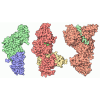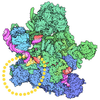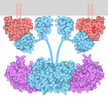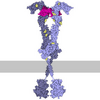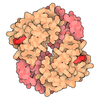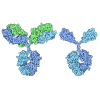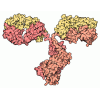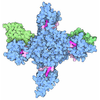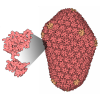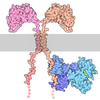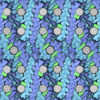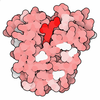[English] 日本語
 Yorodumi
Yorodumi- PDB-9qws: Cryo-EM structure of the human UBR4/KCMF1/CALM1 complex (C-term d... -
+ Open data
Open data
- Basic information
Basic information
| Entry | Database: PDB / ID: 9qws | |||||||||
|---|---|---|---|---|---|---|---|---|---|---|
| Title | Cryo-EM structure of the human UBR4/KCMF1/CALM1 complex (C-term dimer interface focused refinement) | |||||||||
 Components Components |
| |||||||||
 Keywords Keywords | LIGASE / Ubiquitin ligase / protein quality control | |||||||||
| Function / homology |  Function and homology information Function and homology informationnegative regulation of HRI-mediated signaling / synaptic signaling / ubiquitin-dependent protein catabolic process via the N-end rule pathway / protein K27-linked ubiquitination / cytoplasm protein quality control by the ubiquitin-proteasome system / protein branched polyubiquitination / negative regulation of fatty acid biosynthetic process / endosome organization / cytoplasm protein quality control / protein K11-linked ubiquitination ...negative regulation of HRI-mediated signaling / synaptic signaling / ubiquitin-dependent protein catabolic process via the N-end rule pathway / protein K27-linked ubiquitination / cytoplasm protein quality control by the ubiquitin-proteasome system / protein branched polyubiquitination / negative regulation of fatty acid biosynthetic process / endosome organization / cytoplasm protein quality control / protein K11-linked ubiquitination / CaM pathway / Cam-PDE 1 activation / Sodium/Calcium exchangers / Calmodulin induced events / Reduction of cytosolic Ca++ levels / Activation of Ca-permeable Kainate Receptor / CREB1 phosphorylation through the activation of CaMKII/CaMKK/CaMKIV cascasde / Loss of phosphorylation of MECP2 at T308 / CREB1 phosphorylation through the activation of Adenylate Cyclase / CaMK IV-mediated phosphorylation of CREB / PKA activation / negative regulation of high voltage-gated calcium channel activity / Glycogen breakdown (glycogenolysis) / CLEC7A (Dectin-1) induces NFAT activation / Activation of RAC1 downstream of NMDARs / negative regulation of ryanodine-sensitive calcium-release channel activity / organelle localization by membrane tethering / mitochondrion-endoplasmic reticulum membrane tethering / autophagosome membrane docking / negative regulation of calcium ion export across plasma membrane / regulation of cardiac muscle cell action potential / presynaptic endocytosis / Synthesis of IP3 and IP4 in the cytosol / regulation of cell communication by electrical coupling involved in cardiac conduction / Phase 0 - rapid depolarisation / calcineurin-mediated signaling / Negative regulation of NMDA receptor-mediated neuronal transmission / Unblocking of NMDA receptors, glutamate binding and activation / RHO GTPases activate PAKs / Uptake and function of anthrax toxins / Ion transport by P-type ATPases / tertiary granule membrane / regulation of ryanodine-sensitive calcium-release channel activity / Long-term potentiation / protein phosphatase activator activity / Calcineurin activates NFAT / ficolin-1-rich granule membrane / Regulation of MECP2 expression and activity / DARPP-32 events / protein K63-linked ubiquitination / Smooth Muscle Contraction / detection of calcium ion / regulation of cardiac muscle contraction / catalytic complex / RHO GTPases activate IQGAPs / regulation of cardiac muscle contraction by regulation of the release of sequestered calcium ion / protein K48-linked ubiquitination / cellular response to interferon-beta / specific granule membrane / calcium channel inhibitor activity / Activation of AMPK downstream of NMDARs / Protein methylation / presynaptic cytosol / regulation of release of sequestered calcium ion into cytosol by sarcoplasmic reticulum / Ion homeostasis / eNOS activation / titin binding / Tetrahydrobiopterin (BH4) synthesis, recycling, salvage and regulation / sperm midpiece / regulation of calcium-mediated signaling / voltage-gated potassium channel complex / calcium channel complex / FCERI mediated Ca+2 mobilization / positive regulation of autophagy / substantia nigra development / regulation of heart rate / Ras activation upon Ca2+ influx through NMDA receptor / FCGR3A-mediated IL10 synthesis / Antigen activates B Cell Receptor (BCR) leading to generation of second messengers / calyx of Held / adenylate cyclase activator activity / sarcomere / VEGFR2 mediated cell proliferation / protein serine/threonine kinase activator activity / regulation of cytokinesis / VEGFR2 mediated vascular permeability / spindle microtubule / positive regulation of receptor signaling pathway via JAK-STAT / Translocation of SLC2A4 (GLUT4) to the plasma membrane / calcium channel regulator activity / RAF activation / Transcriptional activation of mitochondrial biogenesis / response to calcium ion / RING-type E3 ubiquitin transferase / cellular response to type II interferon / Stimuli-sensing channels / G2/M transition of mitotic cell cycle / long-term synaptic potentiation / spindle pole / ubiquitin-protein transferase activity Similarity search - Function | |||||||||
| Biological species |  Homo sapiens (human) Homo sapiens (human) | |||||||||
| Method | ELECTRON MICROSCOPY / single particle reconstruction / cryo EM / Resolution: 3.1 Å | |||||||||
 Authors Authors | Grabarczyk, D.B. / Clausen, T. | |||||||||
| Funding support |  Austria, European Union, 2items Austria, European Union, 2items
| |||||||||
 Citation Citation |  Journal: Science / Year: 2025 Journal: Science / Year: 2025Title: Architecture of the UBR4 complex, a giant E4 ligase central to eukaryotic protein quality control. Authors: Daniel B Grabarczyk / Julian F Ehrmann / Paul Murphy / Woo Seok Yang / Robert Kurzbauer / Lillie E Bell / Luiza Deszcz / Jana Neuhold / Alexander Schleiffer / Alexandra Shulkina / Juyeon Lee ...Authors: Daniel B Grabarczyk / Julian F Ehrmann / Paul Murphy / Woo Seok Yang / Robert Kurzbauer / Lillie E Bell / Luiza Deszcz / Jana Neuhold / Alexander Schleiffer / Alexandra Shulkina / Juyeon Lee / Jin Seok Shin / Anton Meinhart / Gijs A Versteeg / Eszter Zavodszky / Hyun Kyu Song / Ramanujan S Hegde / Tim Clausen /    Abstract: Eukaryotic cells have evolved sophisticated quality control mechanisms to eliminate aggregation-prone proteins that compromise cellular health. Central to this defense is the ubiquitin-proteasome ...Eukaryotic cells have evolved sophisticated quality control mechanisms to eliminate aggregation-prone proteins that compromise cellular health. Central to this defense is the ubiquitin-proteasome system, where UBR4 acts as an essential E4 ubiquitin ligase, amplifying degradation marks on defective proteins. Cryo-electron microscopy analysis of UBR4 in complex with its cofactors KCMF1 and CALM1 reveals a massive 1.3-megadalton ring structure, featuring a central substrate-binding arena and flexibly attached catalytic units. Our structure shows how UBR4 binds substrate and extends lysine-48-specific ubiquitin chains. Efficient substrate targeting depends on both preubiquitination and specific N-degrons, with KCMF1 acting as a key substrate filter. The architecture of the E4 megacomplex is conserved across eukaryotes, but species-specific adaptations allow UBR4 to perform its precisely tuned quality control function in diverse cellular environments. | |||||||||
| History |
|
- Structure visualization
Structure visualization
| Structure viewer | Molecule:  Molmil Molmil Jmol/JSmol Jmol/JSmol |
|---|
- Downloads & links
Downloads & links
- Download
Download
| PDBx/mmCIF format |  9qws.cif.gz 9qws.cif.gz | 628.1 KB | Display |  PDBx/mmCIF format PDBx/mmCIF format |
|---|---|---|---|---|
| PDB format |  pdb9qws.ent.gz pdb9qws.ent.gz | 421.1 KB | Display |  PDB format PDB format |
| PDBx/mmJSON format |  9qws.json.gz 9qws.json.gz | Tree view |  PDBx/mmJSON format PDBx/mmJSON format | |
| Others |  Other downloads Other downloads |
-Validation report
| Summary document |  9qws_validation.pdf.gz 9qws_validation.pdf.gz | 1.5 MB | Display |  wwPDB validaton report wwPDB validaton report |
|---|---|---|---|---|
| Full document |  9qws_full_validation.pdf.gz 9qws_full_validation.pdf.gz | 1.5 MB | Display | |
| Data in XML |  9qws_validation.xml.gz 9qws_validation.xml.gz | 73.2 KB | Display | |
| Data in CIF |  9qws_validation.cif.gz 9qws_validation.cif.gz | 112.8 KB | Display | |
| Arichive directory |  https://data.pdbj.org/pub/pdb/validation_reports/qw/9qws https://data.pdbj.org/pub/pdb/validation_reports/qw/9qws ftp://data.pdbj.org/pub/pdb/validation_reports/qw/9qws ftp://data.pdbj.org/pub/pdb/validation_reports/qw/9qws | HTTPS FTP |
-Related structure data
| Related structure data |  53426MC  9jniC  9lgsC  9qt9C  9qwuC  9qwxC  9qwzC  9qx0C  9qx1C  9qx2C  9qx5C  9upzC M: map data used to model this data C: citing same article ( |
|---|---|
| Similar structure data | Similarity search - Function & homology  F&H Search F&H Search |
- Links
Links
- Assembly
Assembly
| Deposited unit | 
|
|---|---|
| 1 |
|
- Components
Components
| #1: Protein | Mass: 17980.717 Da / Num. of mol.: 2 Source method: isolated from a genetically manipulated source Source: (gene. exp.)  Homo sapiens (human) / Gene: CALM1, CALM, CAM, CAM1 / Production host: Homo sapiens (human) / Gene: CALM1, CALM, CAM, CAM1 / Production host:  Trichoplusia ni (cabbage looper) / References: UniProt: P0DP23 Trichoplusia ni (cabbage looper) / References: UniProt: P0DP23#2: Protein | Mass: 575844.000 Da / Num. of mol.: 2 Source method: isolated from a genetically manipulated source Source: (gene. exp.)  Homo sapiens (human) / Gene: UBR4, KIAA0462, KIAA1307, RBAF600 / Production host: Homo sapiens (human) / Gene: UBR4, KIAA0462, KIAA1307, RBAF600 / Production host:  Trichoplusia ni (cabbage looper) Trichoplusia ni (cabbage looper)References: UniProt: Q5T4S7, RING-type E3 ubiquitin transferase #3: Protein | Mass: 43192.648 Da / Num. of mol.: 2 Source method: isolated from a genetically manipulated source Source: (gene. exp.)  Homo sapiens (human) / Gene: KCMF1, FIGC, ZZZ1 / Production host: Homo sapiens (human) / Gene: KCMF1, FIGC, ZZZ1 / Production host:  Trichoplusia ni (cabbage looper) Trichoplusia ni (cabbage looper)References: UniProt: Q9P0J7, RING-type E3 ubiquitin transferase #4: Chemical | Has ligand of interest | N | Has protein modification | N | |
|---|
-Experimental details
-Experiment
| Experiment | Method: ELECTRON MICROSCOPY |
|---|---|
| EM experiment | Aggregation state: PARTICLE / 3D reconstruction method: single particle reconstruction |
- Sample preparation
Sample preparation
| Component | Name: Human UBR4/KCMF1/CALM1 complex / Type: COMPLEX / Entity ID: #1-#3 / Source: RECOMBINANT |
|---|---|
| Molecular weight | Experimental value: NO |
| Source (natural) | Organism:  Homo sapiens (human) Homo sapiens (human) |
| Source (recombinant) | Organism:  Trichoplusia ni (cabbage looper) Trichoplusia ni (cabbage looper) |
| Buffer solution | pH: 7.5 |
| Specimen | Embedding applied: NO / Shadowing applied: NO / Staining applied: NO / Vitrification applied: YES |
| Vitrification | Cryogen name: ETHANE |
- Electron microscopy imaging
Electron microscopy imaging
| Experimental equipment |  Model: Titan Krios / Image courtesy: FEI Company |
|---|---|
| Microscopy | Model: TFS KRIOS |
| Electron gun | Electron source:  FIELD EMISSION GUN / Accelerating voltage: 300 kV / Illumination mode: FLOOD BEAM FIELD EMISSION GUN / Accelerating voltage: 300 kV / Illumination mode: FLOOD BEAM |
| Electron lens | Mode: BRIGHT FIELD / Nominal defocus max: 2000 nm / Nominal defocus min: 800 nm |
| Image recording | Electron dose: 50 e/Å2 / Film or detector model: FEI FALCON IV (4k x 4k) |
- Processing
Processing
| EM software | Name: PHENIX / Category: model refinement | ||||||||||||||||||||||||
|---|---|---|---|---|---|---|---|---|---|---|---|---|---|---|---|---|---|---|---|---|---|---|---|---|---|
| CTF correction | Type: PHASE FLIPPING AND AMPLITUDE CORRECTION | ||||||||||||||||||||||||
| Symmetry | Point symmetry: C2 (2 fold cyclic) | ||||||||||||||||||||||||
| 3D reconstruction | Resolution: 3.1 Å / Resolution method: FSC 0.143 CUT-OFF / Num. of particles: 135406 / Symmetry type: POINT | ||||||||||||||||||||||||
| Refinement | Highest resolution: 3.1 Å Stereochemistry target values: REAL-SPACE (WEIGHTED MAP SUM AT ATOM CENTERS) | ||||||||||||||||||||||||
| Refine LS restraints |
|
 Movie
Movie Controller
Controller

















 PDBj
PDBj
